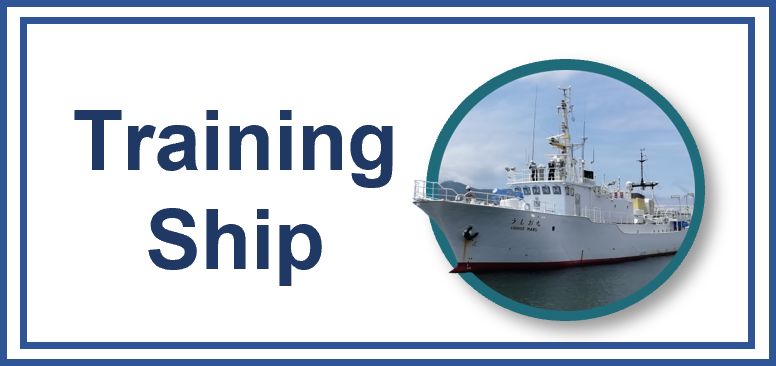Ocean Observation Methods
Section outline
-
As shown in the "Oshoro-Maru Ocean Observation Chart" below, there are a wide variety of oceanographic observation methods using ships, including towing (towing), placing on the seafloor (mooring), releasing from the ship into the ocean (drifting), and indirect measurement using sound waves, in addition to lowering instruments into the ocean with a wire rope extended from a stationary ship. In this section, we will explain the five main observation methods: (1) CTD observation, (2) biological sampling, (3) water sampling, (4) geological sample collection, and (5) acoustic measurement.
おしょろ丸 海洋観測図 Oshoro-Maru Ocean Observation Chart
北海道大学 Hokkaido University
海洋調査部 Oshoro-maru Marine Science Department
科学計量魚群探知機 Scientific Quantitative Fish Finder
極深海音響測深器 Extreme-Deep-Sea Acoustic Bathymetric Instrument
ソナードーム Sonar Dome
ドップラー式多層流向流速計(ADCP) Acoustic Doppler Current Profiler
マルチナロービーム音響測深機 Multi-narrow-beam echo sounder
CTD採水システム CTD sampling systems
自己記録式CTD Self-recording CTD
NORPACネット NORPAC net
稚魚ネット Fry nets
ピンガー Pinger
マルチプルコアラ― Multiple Coaler
ピストンコアラ― Piston Coaler
海底地震計 Seafloor Seismograph
ORIネット ORI Net
MTDネット MTD Net
ソリネット Solinet
漂流トラップ Drift trap
係留系 Mooring system -
Water temperature and salinity are the most fundamental characteristics of seawater, and CTD (Conductivity-Temperature-Depth profiler) observations that measure their vertical distribution are fundamental to ocean observations. This is because water temperature and salinity are not only variables that determine the "density" that governs the dynamics of seawater, but are also important factors that influence biological and chemical processes in the ocean. Furthermore, CTD observations are also essential in the field of acoustic measurement, as represented by bathymetry, to estimate underwater sound velocity and sound wave absorption and attenuation.
→Method of Ocean Observation (1) CTD Observation
CTD採水システム CTD water sampling system -
Biological specimens have long been collected at marine research sites. During the aforementioned expedition by the Challenger, more than 4,000 species of unknown marine life were discovered. Even today, marine organisms are collected using a variety of methods according to the purpose of the research in order to determine "where" in the ocean "what" organisms exist and "how many" they are. The collected biological samples are used not only for research on the physiology and ecology of individual species, but also to elucidate the interaction between the global environment and marine organisms (ecosystems).
→Method of Ocean Observation (2) Biological Collection
プランクトンネットの一種 A type of plankton net
NORPACネット NORPAC net -
The major component dissolved in seawater is sodium chloride, which is responsible for the salty taste of seawater. In addition, nutrients necessary for phytoplankton growth, gaseous components such as nitrogen, oxygen, and carbon dioxide, organic compounds from various origins, and particulate matter from viruses, bacteria, and minerals are dissolved and mixed to make up seawater. By collecting seawater samples, analyzing their composition, and understanding their distribution in the ocean, we are trying to clarify the environmental dynamics of the oceans and the evolution of the global environment.
To collect seawater from a certain layer in the ocean, an instrument called a water sampler is used. The sampler is lowered to the desired depth with the lid open, and the lid is closed on the spot to collect seawater from an arbitrary layer. In addition, seawater is collected by pumping or scooping it up with a bucket. The distribution of seawater components can be continuously determined by measuring the pumped seawater with a sensor or by introducing it directly into an analyzer.
As the diversity of analysis items and the accuracy of analysis have increased, water samplers have become larger and larger. While the amount of seawater required for analysis has decreased, it is now necessary to collect more seawater to minimize the effects of contamination. In addition, improvements have been made to the materials and mechanisms of water samplers to prevent even the slightest contamination.→Method of Ocean Observation 3) Water sampling
海水の採取に用いられるニスキン採水器 Niskin water samplers for seawater sampling
溶存酸素濃度の分析 Analysis of dissolved oxygen concentration
試水の分取作業(配水)の様子 Sample water sampling operation (water distribution)
褐色沈殿として固定された溶存酸素 Dissolved oxygen fixed as brown precipitation
自動滴定装置を用いた溶存酸素の定量分析 Quantitative analysis of dissolved oxygen using autotitrator -
Sedimentary layers are formed on the ocean floor by the accumulation of particles such as mud, sand, and gravel over a long period of time. By collecting sediments from the seafloor and studying their characteristics in detail, we try to decipher the past events (geological events, changes in sea water temperature, etc.) that occurred during the formation of the sedimentary layers, and use this information to predict the future of the global environment. Sediments are also collected for the exploration of resources lying beneath the seafloor and for the collection of organisms living on the seafloor.
If we look further down in the sedimentary layers, we find a layer of solid rock (the earth's crust). By collecting rocks from the crust and analyzing their chemical composition and structure, we can learn about their formation and degeneration. The distribution characteristics of the rocks that make up the earth's crust are closely related to the plate motions that are believed to cause earthquakes, and it is hoped that the collection of rock samples will help elucidate the mechanisms that generate earthquakes.→Method of Ocean Observation (4) Geological sample collection
採泥器の一種(マルチプルコアラー) A type of mud sampler (multiple corer)
柱状採泥器によって採取された堆積物コア Sediment core collected by a columnar corer -
Sound waves are often used for remote sensing and data transmission underwater. This is because sound waves propagate much farther than electromagnetic waves (light, radio waves, etc.), which are absorbed and attenuated underwater. The technology to detect sound signals emitted from a ship and bounced back to measure the distance to a distant object is called sonar (SONAR: SOund and NAvigation Ranging) and is indispensable for safe navigation. Sonic exploration technology, which began to develop after the sinking of the Titanic in 1912, is now used not only for depth measurement (distance from the water surface to the seafloor), but also for many underwater acoustic techniques such as fish detection and current velocity measurement, and is used as a means of quickly and extensively monitoring the state of the ocean.
→Method of Ocean Observation (5) Acoustic Measurement
マルチナロービーム音響測深器による海底地形探査 Seafloor Topographic Survey with Multi-Narrow Beam Acoustic Bathymetry
計量魚群探知機のエコーグラム Echogram of a metering fish finder



